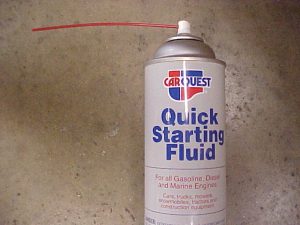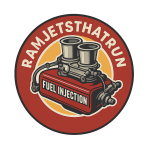Almost all fuel injected Corvettes with starting problems are equipped with Cranking Signal Valves. The CSV is an ingenious device that just doesn’t work very reliably in the real world. It is designed to pass about 1” water of manifold (plenum) vacuum to the main diaphragm to make an FI unit squirt gas from its nozzles during engine cranking. When the engine starts and the plenum vacuum jumps above 19″ water (1.4″ mercury), the CSV is supposed to shut tight. Well, that was the original theory anyway. Early FI Corvette owners quickly found that the CSV could suddenly fail with no warning. However, it almost always failed partially open. This allowed too much plenum vacuum to the main diaphragm, making the FI unit run very rich. Once a CSV failed you could still start the engine, but it would run so rich it wouldn’t idle properly.
A Corvette engine with the 097 “Duntov” camshaft can make as much as 22″ water vacuum in the plenum while cranking IF the throttle is fully shut and the Cranking Signal Valve is not bleeding off any vacuum to the main diaphragm. However, these aren’t normal cold starting conditions for FI engines. Usually the throttle is partially open because of the fast idle cam position. Also, the Cranking Signal Valve is letting some of the plenum vacuum go to the main diaphragm. Under typical cold start conditions for FI engines, the plenum vacuum varies in rapid pulses between 4″ and 7″ of water. This lower-than-optimum plenum vacuum is actually a good thing. If the plenum vacuum was over 14″ water, the Cranking Signal Valve would be essentially shut and should not pass enough vacuum to make the FI unit squirt any fuel from the nozzles.
You’re probably wondering how much vacuum is required at the main diaphragm for an FI unit to shoot a steady stream of fuel from the nozzles at cranking speed (150 – 200 rpm). The answer may surprise you; it certainly did me when I tested two units to find out. Only .5″ to .7″ water vacuum is needed at the main diaphragm during cranking to generate a good fuel stream at all nozzles. That’s not very much vacuum. Engine manifold (plenum) vacuum is normally measured in inches of mercury. One inch of mercury vacuum equals 13.6 inches of water vacuum. This means that plenum vacuum during a normal cold start is less than .5″ mercury, and that only about .07″ mercury vacuum is passed by the CSV to the main diaphragm.
My tests of Cranking Signal Valves were also a little surprising to me. I found that the plenum vacuum passed by these valves is extremely low. Under normal cold engine cranking conditions (rapidly pulsing 4″ – 7″ water plenum vacuum), most good cranking signal valves will pass about 1″ water vacuum. The dozen CSV valves I tested passed the highest vacuum to the main diaphragm when the plenum vacuum (at the threaded CSV nipple) was only 2″ water. Above that plenum vacuum level, the vacuum passed by the CSV went down quite rapidly. Most good CSV’s stop passing any significant vacuum at about 14″ water plenum vacuum.
I believe these are the leading causes of CSV equipped FI engines failing to start quickly when cold:
- A low gas level in the fuel meter bowl.
- A tiny vacuum leak at the main diaphragm or in the signal tubing connections above it.
- Too much liquid gas in the cylinders (liquid gasoline won’t explode, it has to vaporize first).
- A spill valve that is not fully seated (causing it to sit low in the fuel meter casting).
- A very slow engine cranking speed (not generating enough plenum vacuum).
- Too much plenum vacuum during cranking (shutting the CSV).

